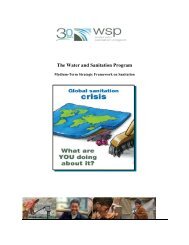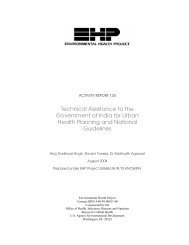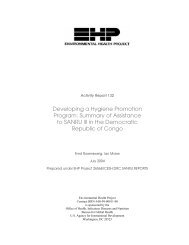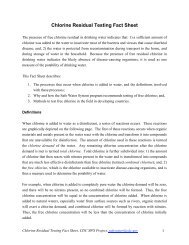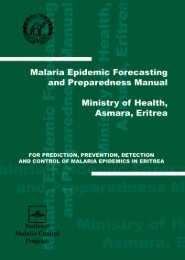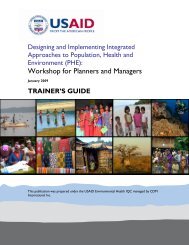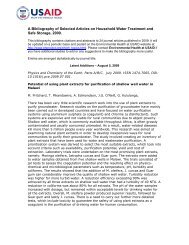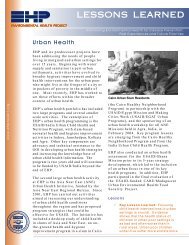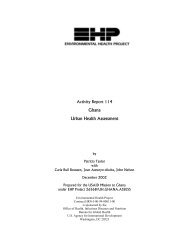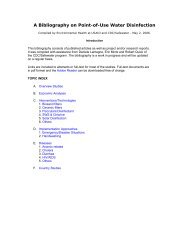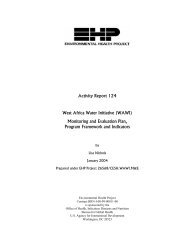Changing Glaciers and Hydrology in Asia - Environmental Health at ...
Changing Glaciers and Hydrology in Asia - Environmental Health at ...
Changing Glaciers and Hydrology in Asia - Environmental Health at ...
- No tags were found...
Create successful ePaper yourself
Turn your PDF publications into a flip-book with our unique Google optimized e-Paper software.
collection are based on an ongo<strong>in</strong>g effort to better underst<strong>and</strong>, prepare for, mitig<strong>at</strong>e, <strong>and</strong> adaptto the impacts of glacier melt. Moreover, such programs are feasible <strong>in</strong> almost all countries;experience shows th<strong>at</strong> countries can cooper<strong>at</strong>e on scientific programs even when they have fewother cooper<strong>at</strong>ive efforts.Other large vulnerabilities arise from current deficits <strong>in</strong> health <strong>and</strong> popul<strong>at</strong>ion conditions <strong>and</strong>economic resources, as shown <strong>in</strong> Section 3. Scientists may disagree about whether, for <strong>in</strong>stance,there may be too much or too little w<strong>at</strong>er (floods or droughts), <strong>and</strong> the evidence is mixed. But<strong>in</strong> many areas people may be vulnerable (likelyto be harmed) by any change <strong>in</strong> w<strong>at</strong>er supply or<strong>in</strong> the tim<strong>in</strong>g of w<strong>at</strong>er availability dur<strong>in</strong>g thegrow<strong>in</strong>g season. People who are ill-nourished,have more children than they want <strong>and</strong> cansupport, <strong>and</strong> are mired <strong>in</strong> poverty <strong>and</strong>dependent on scarce n<strong>at</strong>ural resources havevery limited capacity to deal with or adapt tochange. These vulnerabilities are identified <strong>in</strong>both projections of clim<strong>at</strong>e change impacts <strong>and</strong><strong>in</strong> general development efforts, mak<strong>in</strong>g this anarea where co-benefits will n<strong>at</strong>urally arise.Recogniz<strong>in</strong>g these exist<strong>in</strong>g vulnerabilities fac<strong>in</strong>glarge popul<strong>at</strong>ions downstream from glaciers, thesecond program concept <strong>in</strong> this sectionaddresses both near-term preparedness (toGLOFs <strong>and</strong> the disappearance of some glaciers)<strong>and</strong> resilience-build<strong>in</strong>g to exist<strong>in</strong>g vulnerabilities.These vulnerabilities <strong>in</strong>clude w<strong>at</strong>er stress <strong>and</strong>associ<strong>at</strong>ed food <strong>and</strong> nutritional deficits; healthissues–particularly popul<strong>at</strong>ion pressures <strong>and</strong>diarrheal diseases associ<strong>at</strong>ed with poor w<strong>at</strong>erquality–as well as malnutrition; thre<strong>at</strong>s toQuestions th<strong>at</strong> Cannot Be Answeredwith Current KnowledgeHow will seasonalw<strong>at</strong>er flows change?Will more snow fall?More ra<strong>in</strong>? Howmuch?How will crop yieldschange? Wh<strong>at</strong> will theeffect on foodsecurity be?How will people copewith <strong>in</strong>creas<strong>in</strong>g w<strong>at</strong>erstress, <strong>in</strong>clud<strong>in</strong>gscarce w<strong>at</strong>er fordr<strong>in</strong>k<strong>in</strong>g, sanit<strong>at</strong>ion<strong>and</strong> hygiene?Will there be flood<strong>in</strong>gfrom acceler<strong>at</strong>edmelt? Where?Will arid l<strong>and</strong>sbecome more arid?How much <strong>and</strong> when?How will economicsectors, such astourism <strong>and</strong> energy,be impacted?Wh<strong>at</strong> will be thehealth effects,<strong>in</strong>clud<strong>in</strong>g diseases,malnutrition, <strong>and</strong>m<strong>at</strong>ernal <strong>and</strong> childhealth?ecosystems, particularly biodiversity; <strong>and</strong> potential governance <strong>and</strong> conflict implic<strong>at</strong>ions ofunstable w<strong>at</strong>er supply. The three program approaches focus on (1) improv<strong>in</strong>g the managementof w<strong>at</strong>er resources, (2) conserv<strong>in</strong>g ecosystems, <strong>and</strong> (3) prepar<strong>in</strong>g high-mounta<strong>in</strong> communitiesfor direct impacts of glacier melt.F<strong>in</strong>ally, efforts to reduce clim<strong>at</strong>e-chang<strong>in</strong>g emissions of black carbon <strong>and</strong> other aerosols willreduce the need to adapt to clim<strong>at</strong>e change – <strong>and</strong> <strong>at</strong> the same time, yield health benefits topeople as they bre<strong>at</strong>he less polluted air, both <strong>in</strong>doors <strong>and</strong> outdoors. These issues are discussed<strong>in</strong> both Sections 2 <strong>and</strong> 3.The third program concept <strong>and</strong> approach address these two different issues simultaneously, thuspresent<strong>in</strong>g comb<strong>in</strong>ed opportunities for program <strong>in</strong>tegr<strong>at</strong>ion <strong>and</strong> co-benefits. Black carbon <strong>and</strong>other aerosols likely change the regional clim<strong>at</strong>e <strong>and</strong> acceler<strong>at</strong>e glacier melt when black carbon50



